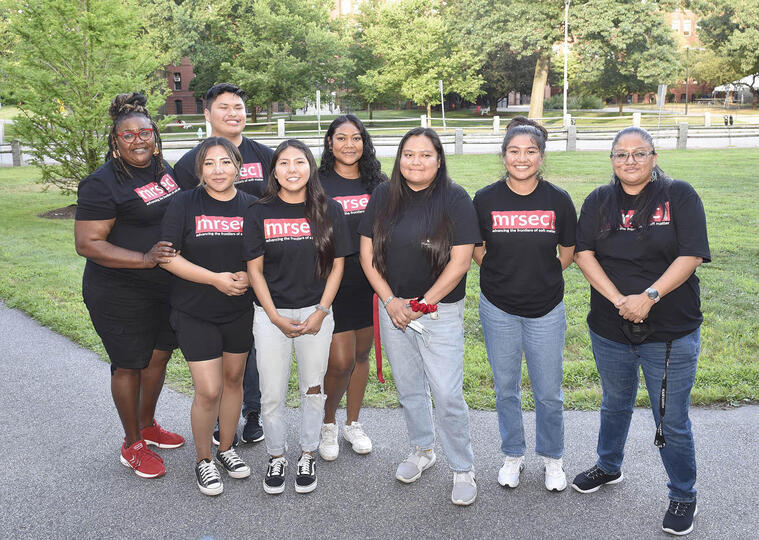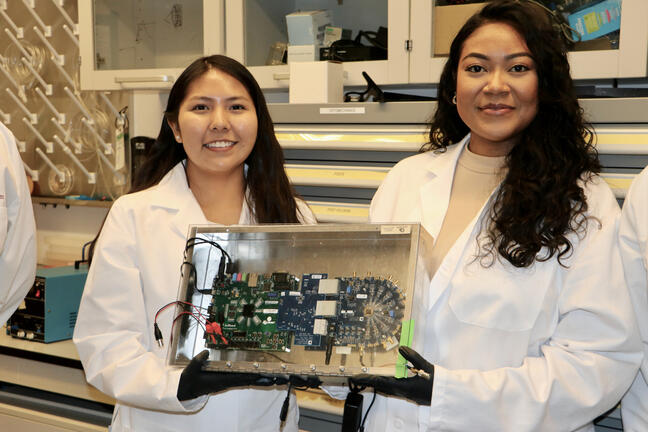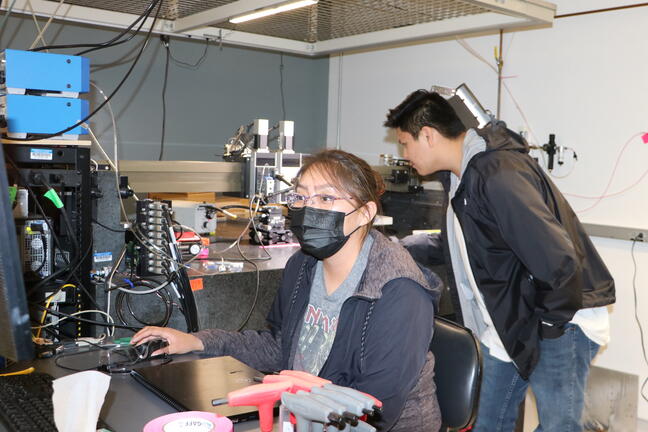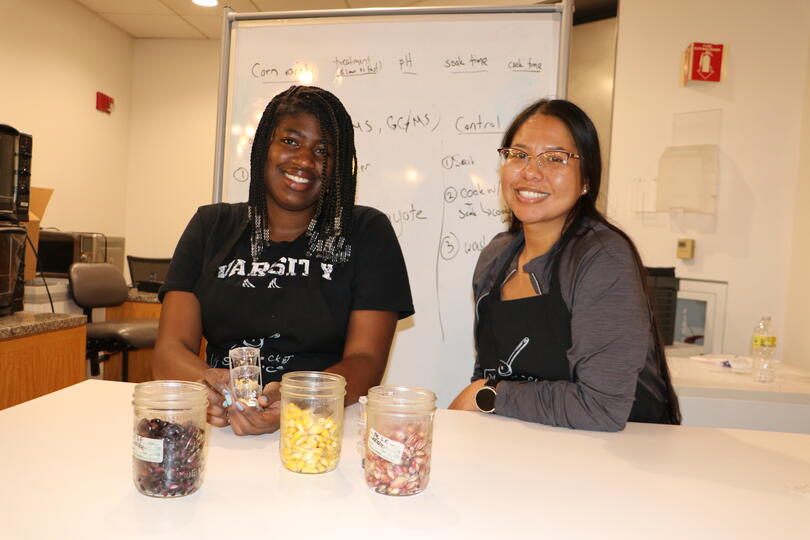Researching Navajo Materials Science
NTU students present research at 2022 Harvard SEAS REU summer symposium
August 11, 2022
Students from Navajo Technical University (NTU) spent the 10 weeks during the summer at the Harvard John A. Paulson School of Engineering and Applied Sciences (SEAS) researching various topics, including the antimicrobial properties of traditional medicinal plants, more affordable ways to 3D print components for renewable energy flow batteries, a robotic gripper students can assemble in classrooms, and the science underlying traditional Navajo rug weaving.
They presented their results during the Research Experience for Undergraduates (REU) Symposium at the Science and Engineering Complex. The symposium consisted of 41 presentations over three days with students representing 26 universities and colleges across the United States.

NTU student Jonathan Chinana who helped develop the soft robotic gripper toolkit, "I really struggled with education when I was growing up, and I know how it is to really take things on your own and try to learn as best you can. Every time I introduce soft robotics to different educators and students, the majority of them see it as something new and different. Just seeing that and introducing it to Native students, they might see it and think of something on their own. This is just a push for them to go into STEM."
The SEAS-NTU partnership began in 2018 through the National Science Foundation Materials Research Science and Engineering Center at Harvard. The "Partnership for Research and Education in Materials: Vision for Excellence at NTU in Research and Education in STEM" is designed to increase the number of students in New Mexico, including Native Americans to pursue undergraduate, graduate, and Ph.D. degrees in STEM. By increasing the research infrastructure at NTU, students can further investigate and address challenges within their own communities, increase the number of students in New Mexico seeking advanced degrees in materials science with the benefit of researching and integrating generational Native American perspectives and methods into materials science exploration.
"It's very important, because a lot of people don't get to see the Navajo science," said Keanu Simpson, an intern in the Diné Culture, Language and Leadership program who presented on NTU's six-week course in traditional rug weaving. "We have to come here and explain."
The partnership's three main areas of research focus on microfluidic systems, electrochemical materials and energy storage, and dynamic soft materials. NTU students presented research in all three fields at this year's symposium.
"It's amazing to see them branch out," said Brandon James, Simpson's partner for the rug weaving presentation. "I know many of the students personally, and to see them do all this really cool stuff is nice to see and witness."
Chelsie Whitewater analyzed how traditional medicinal plants such as Navajo tea, sage, juniper, cliffrose, and yucca fruit inhibit the growth of E. coli and staphylococcus bacteria. She conducted her work at NTU under the guidance of NTU biology professor Irene Ane Anyangwe, in collaboration with the lab of David Weitz, Mallinckrodt Professor of Physics and of Applied Physics. Fellow NTU students working in the Weitz Lab included Zabari-Obyoni Bell and Tionna Tapaha, who worked on a microfluidic sorting device to help with cell analysis, and Layla James and Katelyn Wilson, who helped develop an emulsion technique to help clinical diagnosticians analyze DNA.
"In our culture, we know the plants work," said Whitewater. "I had two main objectives for my research: determine the chemical structures of the plants I've collected and determine their antimicrobial properties."


For electrochemical materials, Justin Platero and Samantha Francis researched 3D printed flow battery components in the lab of Jennifer Lewis, Hansjorg Wyss Professor of Biologically Inspired Engineering. Flow batteries provide a safe way to store energy from intermittent renewable sources such as wind or solar, and 3D printed components could make such batteries more affordable in Navajo communities.
"There's a high need for renewable energy resources," Platero said. "Within the last 100 years, the world's energy consumption increased dramatically. We're really reliant on oil and coal, which is a big concern, because they produce harmful greenhouse emissions which affect our climate."
For soft materials, Chinana helped develop the robotic gripper toolkit in the lab of Conor Walsh, Paul A. Maeder Professor of Engineering and Applied Sciences. His lab mates included SEAS rising fourth-year student Abigail Lockhart-Calpito, who is pursuing an S.B. in mechanical engineering.
Other NTU presenters included Breanna Thompson who worked with Christina Perry from Southern University and A&M College in Louisiana to analyze the physical and nutritional effects of nixtamalization, a traditional technique to prepare corn. Simpson and James presented on the history and technique of Navajo rug weaving.

"Our Navajo represent the essence of STEM," Simpson said. "Through rug weaving, our elders practiced mathematics, using their own system of numbers to calculate their warp strings. They even used odd and even number warp counts as a way to create design patterns. Our elders practice chemistry through plant work and the process of dyeing wool, striping colors from plants to dye white sheep wool. Engineering came to play when our elders had to build new tools to help them with their projects. They would turn wood or metal scraps into workable tools."
The partnership with NTU has led to multiple Native American students pursuing degrees at SEAS. Robinson Tom, the first graduate of NTU's biology program, went on to join the SEAS Post-Baccalaureate Program and Harvard Research Scholars Initiative, and will join the Weitz Group as a Ph.D. in bioengineering candidate in the fall. Bell, fresh off the 10-week REU this summer, will also join the Research Scholars Initiative in the fall, as will 2022 NTU graduate Michael Nelwood.
"To be Navajo, and to be here and present part of our culture on the East Coast is a big deal," James said. "Science and our Navajo culture intertwine together. They go hand in hand."
Press Contact: By Matt Goisman | mgoisman@g.harvard.edu
Authorship, funding, disclosures, ownership
The Harvard University Materials Research Science and Engineering Center (MRSEC), and Harvard-NTU Partnership in Research Education in Materials (PREM) are supported through the auspices of the National Science Foundation (MRSEC DMR-2011754 and PREM DMR-2122195).
